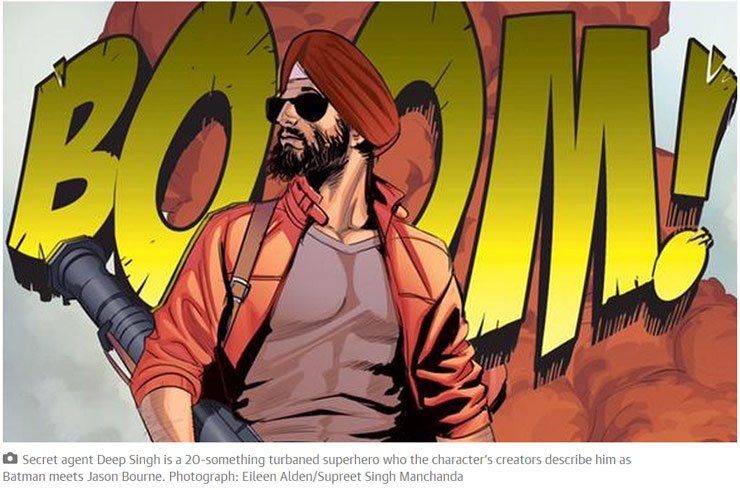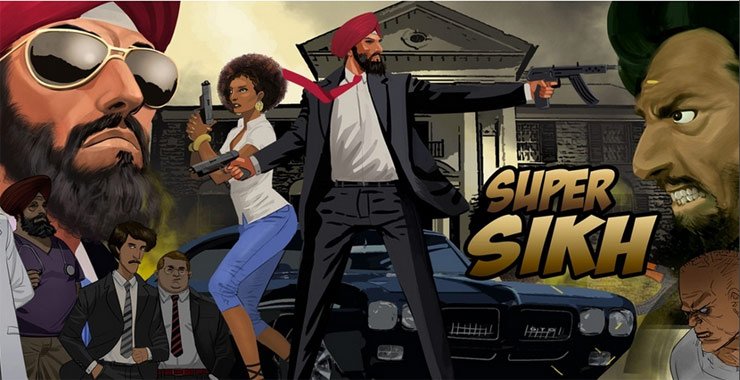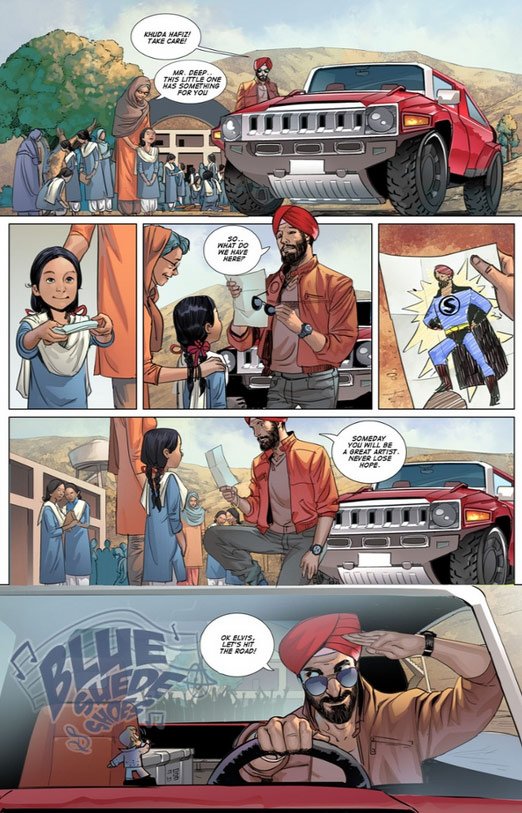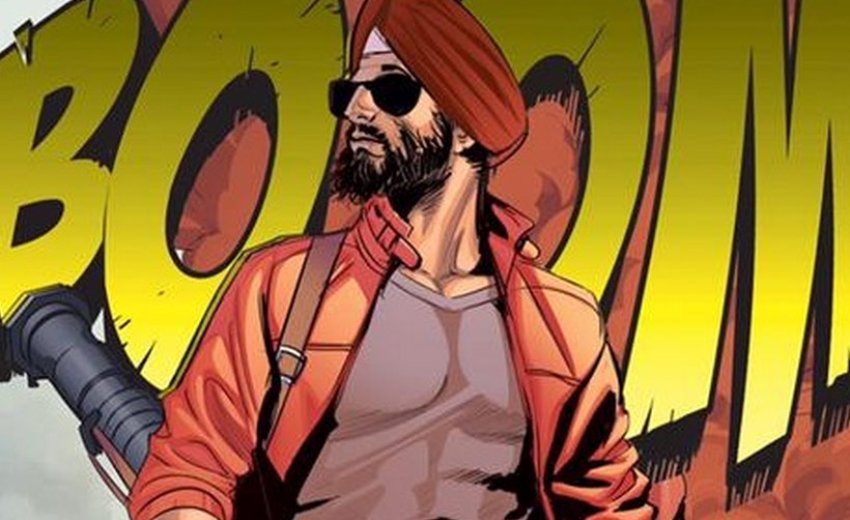
When a group of Sikh children were asked who their favourite superheroes are, the answers were barely surprising: Iron Man, Batman, Superman and the usual list of DC and Marvel old-hands.
But when they were asked if they knew of a Sikh comic book superhero, their response was unanimous: an emphatic no.
“And then we asked them, ‘Would you like to see one?’ The looks on their faces was just priceless,” says Supreet Singh Manchanda, a technology executive and comic creator based in San Francisco. “They just beamed.”
And that was how Super Sikh, the Elvis-loving, Taliban-fighting superagent, came to be. Created jointly by Manchanda and Eileen Alden, an Oakland-based screenwriter, the series follows Deep Singh, a 20-something turbaned superhero, as he makes a trip to Graceland while fighting off his enemies who want him gone. The creators describe him as Batman meets Jason Bourne.
The project has more than just schoolchildren excited. The Super Sikh Kickstarter campaign met its $5,000 goal within just 27 hours, and made $22,000 in a month. A preview at San Francisco Comic Con brought overwhelming support, and the first issue, available online, has been downloaded all over the world.
Illustrated by award-winning artist Amit Tayal, the intro shows Deep Singh wearing aviator glasses and a turban, putting paid to the evil plans of a Taliban commander who intends to burn books outside a girls’ school in Afghanistan, even as he blares Blue Suede Shoes on his car stereo.
The Elvis connection is one of many motifs. Deep Singh’s father was an Elvis fan, and the hero’s parents disappeared in Africa when he was a child, explains Manchanda. There’s also a nuclear scientist called Gurpreet Kaur, Deep’s ninja master cousin. Manchanda describes her as similar to Q in James Bond.
Not supernatural. He’s multicultural

The comic began when Manchanda met Alden in 2011 and suggested she work on creating a Sikh superhero character. “Would you believe all these Marvel comic characters that are being made into movies?” asks Manchanda. “They’re more than 50 years old, they’re very two dimensional, there’s very little cultural nuance to them, they’re all white.”
From the very beginning, Alden and Manchanda were clear that Super Sikh would have no superpowers. “[Superheroes] have to have this mutation or something of the sort that makes them abnormal and therefore they get some powers.” Deep Singh would have no such mutations.
“He’s trained, he’s educated, he’s multicultural,” Manchanda explains. He wants to emphasise to their young readers that the character is not so different from them. “This can be you and that’s a very powerful message.”
The creators are certain that their project will help inject a modern Sikh character into the popular consciousness. Deep Singh represents strength, its creators say, and he doesn’t tolerate bullies.
“How long is his beard by this age?”
Translating Super Sikh’s values and character traits into the visual language of the comic was hard work, Manchanda and Alden say – and the bulk of it was left to illustrator Amit Tayal.
There were naturally many iterations of the comic. Over various drafts, Deep Singh became fitter, younger, and calmer. “We’re like ‘No we’ve got to tone it down because he’s cool, he doesn’t get fazed. He smiles, he’s happy, he doesn’t get angry,” Manchanda says. Alden adds that their design brief sees Super Sikh as a humble but stylish person. The creators worked over many tiny details. This meant answering questions such as how long would his beard be at his age, Alden says.
Most interesting is Deep Singh’s choice of antagonist - a megalomaniacal Taliban commander called Salar Al Amok.
There is no ambivalence about Deep Singh’s Sikh values. Yet the creators don’t dwell on the fact that his main antagonist is a Muslim fundamentalist. They do not explore the distortions of Islam by fundamentalists, for that is a story for someone else to tell according to Alden.
“Our story is, you’re presented with this situation, how do you respond as a Sikh?” explains Alden, who through the process of researching the comic, learnt the written Punjabi language Gurmukhi to study scriptures and eventually converted to Sikhism.
“We went out of our way to say this has nothing to do with Islam, this has to do with crazy people who don’t know how to live with normal values,” Manchanda clarifies cautiously.
Deep Singh’s battle against terrorists in Afghanistan is used as a device to address the often confused American views of Sikh people.
The pair say this misunderstanding is a particularly American phenomenon. “Remember, in the British ethos, Sikhs don’t have that same [identity]: they may be victims but there’s a lot of respect,” says Manchanda who grew up in Ethiopia and Zambia and went to college in the UK, before moving to Silicon Valley.
“But in the US there’s no positive foil. There’s no Sikh military, there’s no Sikh policemen and that is only now starting to happen,” he says.
“So if you see this person, he’s wearing a turban, there’s this immediate association to a terrorist,” Alden says. She describes placing a Sikh character as the good guy in Afghanistan as combating a two-dimensional image in the “diaspora”.
“So here are the bad guys in turbans doing bad things, and here are the good guys doing these good things so we had to create this counterfoil,” Manchanda explains.

‘It’s so hard to live with good values’
Super Sikh is an artistic project of personal significance to its creators. Manchanda’s parents were teachers working in Africa who encouraged his obsession with comics. Every time the other expats left to go elsewhere, his father would go over and buy all their books, and that’s how Manchanda gathered (and read) comics in different languages and from various places.
Manchanda’s parents encouraged his obsession with comics. His other inspirations were the books of Louis L’Amour and Zane Grey. “The protagonist is always some lone cowboy who doesn’t put up with nonsense where there’s either a crooked sheriff or someone’s trying to take over the ranch.”
Alden says her mixed-race children faced bullying in school, and the idea of a superhero of colour resonated personally.
“The kind of drama that kids have to deal with today, the bullying; it’s hard to live with those good values.”
Alden and Manchanda are particularly pleased with the reception they have received so far. Four issues of the comic will go into print this year, with 1,000 print runs of each issue. The comics are also set to be translated into Spanish, Mandarin and Hindi.
But they don’t intend to remain independent publishers and are considering approaching large publishing houses if that will make distribution easier. Alden says: “The main goal is not a profit motive – it is a purpose motive.”
